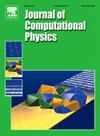在CPU-GPU混合框架下求解浸入边界流固耦合问题的稳定高效半隐式耦合方法
IF 3.8
2区 物理与天体物理
Q2 COMPUTER SCIENCE, INTERDISCIPLINARY APPLICATIONS
引用次数: 0
摘要
本文提出了一种稳定高效的半隐式耦合浸入边界法(IBM),用于模拟CPU-GPU混合框架下的流固耦合问题。该方法通过构造和应用隐式水动力格式提高了数值稳定性,并通过提出基于gpu的并行策略显著提高了计算效率。为了提高稳定性,通过IBM中解耦的速度校正关系获得的水动力被隐式地视为未知数,并将其表示为未知结构速度和预测流场的函数。水动力和结构动力学方程(SD)同时求解。整个求解过程在CPU-GPU异构并行混合框架中实现。为了保证线程安全和CPU和GPU之间的数据传输最小化,计算任务和线程之间建立了唯一的对应关系,优化了整体计算性能。通过在二维和三维情况下对各种刚性和可变形FSI问题的数值模拟,系统地、严格地检验了本方法的准确性、稳定性和效率,从而全面了解了其性能。结果表明,与传统的显式耦合方法相比,该方法不仅将时间步长提高了50%以上,而且适用于具有任意固流密度比的流固耦合问题。计算效率也提高了35 ~ 380倍。目前基于CPU/ gpu的半隐式耦合方法在模拟具有挑战性的刚性和可变形的FSI问题方面具有特别的前景,显示了其广泛的适用性。本文章由计算机程序翻译,如有差异,请以英文原文为准。
A stable and efficient semi-implicit coupling method for fluid-structure interaction problems with immersed boundaries in a hybrid CPU-GPU framework
This paper presents a stable and efficient semi-implicit coupling immersed boundary method (IBM) for simulating fluid-structure interaction problems in a hybrid CPU-GPU framework. The method enhances numerical stability by constructing and applying implicit hydrodynamic force schemes and significantly improves computational efficiency by proposing GPU-based parallel strategies. To enhance stability performance, the hydrodynamic forces obtained by the decoupled velocity correction relationships in IBM are treated implicitly as unknowns and formulated as a function of unknown structural velocities and the predicted flow field. Both the hydrodynamic forces and the equations of structural dynamics (SD) are solved simultaneously. The entire solution procedures are realized in a hybrid CPU-GPU heterogeneous parallel framework. To guarantee thread safety and minimum data transfer between CPU and GPU, the unique correspondence between computational tasks and threads is established, optimizing the overall computational performance. The accuracy, stability, and efficiency of the present method are systematically and rigorously examined by numerical simulations of a variety of rigid and deformable FSI problems in both 2D and 3D cases, providing a comprehensive understanding of its performance. It is demonstrated that the present method not only enlarges the time step by more than 50 % compared with the conventional explicit coupling method but is also suitable for FSI problems with arbitrary solid-to-fluid density ratios. Furthermore, the computational efficiency is also enhanced by 35 to 380 times. The present CPU/GPU-based semi-implicit coupling method is particularly promising in simulating both challenging rigid and deformable FSI problems, demonstrating its wide applicability.
求助全文
通过发布文献求助,成功后即可免费获取论文全文。
去求助
来源期刊

Journal of Computational Physics
物理-计算机:跨学科应用
CiteScore
7.60
自引率
14.60%
发文量
763
审稿时长
5.8 months
期刊介绍:
Journal of Computational Physics thoroughly treats the computational aspects of physical problems, presenting techniques for the numerical solution of mathematical equations arising in all areas of physics. The journal seeks to emphasize methods that cross disciplinary boundaries.
The Journal of Computational Physics also publishes short notes of 4 pages or less (including figures, tables, and references but excluding title pages). Letters to the Editor commenting on articles already published in this Journal will also be considered. Neither notes nor letters should have an abstract.
 求助内容:
求助内容: 应助结果提醒方式:
应助结果提醒方式:


